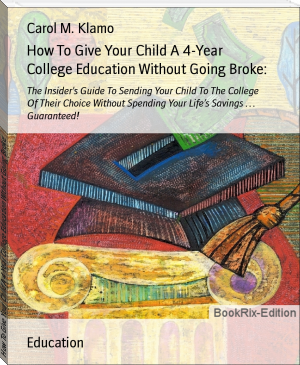How To Give Your Child A 4-Year College Education Without Going Broke: - Carol M. Klamo (top novels to read txt) 📗

- Author: Carol M. Klamo
Book online «How To Give Your Child A 4-Year College Education Without Going Broke: - Carol M. Klamo (top novels to read txt) 📗». Author Carol M. Klamo
Guess Who They’re Gonna Pick?
If you guessed the student with the higher SAT scores, you were right.
Sometimes a higher SAT score can make all the difference between getting into an “O.K.” school and a prestigious university. Not only does a higher SAT score help in college admissions but it can make a significant impact on your bottom line as well when it comes to receiving free money for college.
The small investment you make in a good test preparation service will pay off in high returns for your child.
3. Start Looking For Private Scholarships.
I’m not a big believer in wasting a whole lot of time searching for private scholarships since they only make up about 3.7% of all the funds available for a college education.
But, just like the lottery - “you gotta get in it to win it!” Each year, students are surprising me with how much scholarship money they are able to get their hands on when they roll up their sleeves and get to work.
Have your child ask their high school guidance counselor what local scholarships are available, and have him/her get applications for all the programs that they think they have a shot at.
There are several free scholarship search solutions online like FastWeb.com who maintain a massive scholarship database with incredible matching technology. Encourage your student to do a little online research as well.
4. Start Setting Up Your Income, Assets & Personal Finances To Get The Maximum Amount Of Money From Each School.
Do you have money saved in your child’s name? Are you planning on putting money into your retirement plan this year? Do you know how much your home is really worth according to the financial aid formulas?
If you’re not sure what the answer should be to the above listed questions, you’ve got to find out!
A simple mistake in how you handle any of the above situations could easily cost you $1,000’s, if not tens of thousands in lost financial aid.
You must take control of the process, and understand how the formula works.
Then, and only then, can you use legal and ethical strategies to reduce the amount of money the schools will expect you to pay.
5. Don’t Procrastinate.
This is the most important point on the entire checklist.
If you let “summer fever” take over, and decide to put off doing anything until “after the summer’s over”...
You’re Gonna Lose A Lot Of Money!
Since the financial aid your child will be awarded is based on the current tax year, it is imperative that you start your planning NOW!
Failure to do so WILL cost you a lot of money and lost opportunities to your child.
Don’t make the same mistake that most parents make, and put this planning off until another time.
The Time To Do Something Is Right Now!
Chapter #4
"7 Things You Should Be Doing RIGHT NOW
To Get The Maximum Amount Of Money For Your Child’s College Education..."
1. Have Your Child Apply To At Least 6 - 8 Colleges And Universities.
Pick an assortment of “safety schools”, “competitive schools”, and “reach schools”.
Try to pick, at least, several schools where your child lies in the top 25% of the incoming freshman class.
Otherwise, there is a good likelihood that the schools won‘t give you a good financial aid package since your child won’t be a desirable candidate.
Also, make sure they apply to more than just 1 or 2 schools even if they’re dead set on going to a particular school.
By applying to about 6 - 8 schools, you will greatly increase your ability to negotiate financial aid packages at the end of the year by pitting one school against the other.
2. Figure Out How To Value Your Home Properly.
Most families end up over-valuing their homes for purposes of financial aid. Don’t make this mistake - it could cost you thousands of dollars in lost college funding.
Instead, the schools use a special formula called “The Housing Index Multiplier” which is based on your home’s original purchase price and the year you purchased it.
Find out what your “multiplier” is and use this value for your home.
3. Do Last Minute Income And Asset Planning To Lower Your Out-Of-Pocket Costs.
You MUST set up your finances in a way that will maximize your eligibility for college financial aid.
Assets held in the wrong place will kill your chances of getting money.
Should a parent or sibling attend college part-time to increase your eligibility?
Are you properly valuing your real estate? Do you know what assets are exempt from the financial aid formulas?
If you’re not sure, you’d better find out the answers to these questions quickly before it’s too late!
4. Don’t Apply For Early Decision If You Want To Get The Maximum Amount Of Money From Each School.
If your child applies for early decision, they are locked into going to that school.
This is a huge mistake if you’re trying to get the maximum amount of money for college.
The reality is that if a school knows you have to go to their school if they accept you, they have no competition and can offer you whatever they want.
Therefore, it’s a very bad idea to apply for early decision since you have no leverage to negotiate for a better financial aid package.
5. Find Out Each School’s Deadline For The Financial Aid Applications - And Don’t Miss A Deadline!
The earliest date you can file the Federal financial aid application (which is called the FAFSA) is January 1 of your child's Senior year.
However, many private colleges and universities will also ask you to fill out the CSS Financial Aid Profile. Different schools have different deadlines for this form.
Don’t miss a deadline
- it will cost you a lot of money in lost financial aid!
6. Look For Private Sources Of College Funding.
Don’t waste too much time looking for private scholarships since they only make up 3.7% of all the aid out there, but it’s worth spending a little time looking for these sources.
Focus on local awards from foundations, organizations, and corporations. You can usually get more information on these awards from your child’s high school guidance counselor.
7. Don’t Let High School Guidance Counselors Or College Financial Aid Officers Give You A False Sense Of Security.
Most high school guidance counselors tell parents, “Don’t worry about it - it’s an easy process, just fill out the forms and sit back and wait for your award letter.”
Unfortunately, it’s not that simple!
If you want to get the maximum amount of money from each school, you’ve got to set up your finances properly, fill out the forms accurately and on-time, and negotiate with colleges and universities to get the best possible financial aid package.
Unfortunately, guidance counselors don’t have the time or the training to do these things - so you can’t rely on them to help you maximize your eligibility for college funding.
College aid officers may offer to help you apply for financial aid.
But going to a financial aid officer and asking them to help you get more money from their school is like going to the IRS and asking them to help you save money on your taxes!
It’s not in a school’s best interest to teach you how to get more money from their school. They have a limited number of funds to give out to a large number of people.
Think twice before you let a guidance counselor or college aid officer “help” you apply for college funding - it may turn out to be a very expensive mistake!
Chapter #5
“How To Pick A College Or University That Will
Give You The Best Financial Aid Package--
More FREE Money, Less Loans!”
In this chapter, I’m going to tell you about something that may save you thousands or even tens of thousands of dollars on your child’s college education.
Most families take a completely “backwards” approach when searching for money for college.
Normally, the process goes something like this....
In the child’s junior (or even worse), senior year of high school, they start picking schools they may be interested in going to, and that they believe they can get into based on their grades, SAT scores, extracurricular activities, etc.
Many students pick a grouping of “safety” schools which they know they can get into, “middle of the range” schools which they have a good shot of getting into, and “reach” schools which they would love to attend, but have a slim chance of getting into.
The next step in the process is that the student starts requesting literature from all of these schools (usually towards the end of their junior year of high school or in the summer preceding their senior year).
Once they receive the literature, most families start planning weekend trips to visit one or more of the schools the student is interested in applying to.
This is how most students and families get a “feel” for each college campus, and determine if they would feel comfortable being a student there.
Just in case you haven’t noticed...
All This Traveling From Campus To
Campus Costs You A Lot Of Time And Money.
It also happens to be the “wrong” way to do things if you want to be in control of the college selection process and get the maximum amount of financial aid from each school.
What most parents and students don’t understand is that...
Your Child Will Probably Be Accepted To
Approximately 70% Of The Schools They Apply To!
Unless, of course, your child is a borderline student, and they’re applying to the Ivy League or the most competitive schools.
If your child is not applying only to reach schools or the Ivy League...
They Have A Good Shot At Getting Into
Most Of The Schools They’re Applying To!
You see, it’s not like 10 or 15 years ago, when there were more seats available than there were students applying to college.
Today, college admissions are very competitive and most colleges are turning away applicants, but they still need students (like your child) to help pay their bills.
This is great news for parents. This puts you in the driver’s seat if, and only if, you know how to take advantage of this trend.
Do you want to know the “right” way to look for colleges and universities for your child?
You do? Good, then let’s continue on.
Instead of blindly picking schools purely based on academic criteria, or sports criteria, or because your friend or relative’s son loves a particular college, you must look at one other very important criteria...
Can This School Meet My Family’s Financial Need And Give





Comments (0)